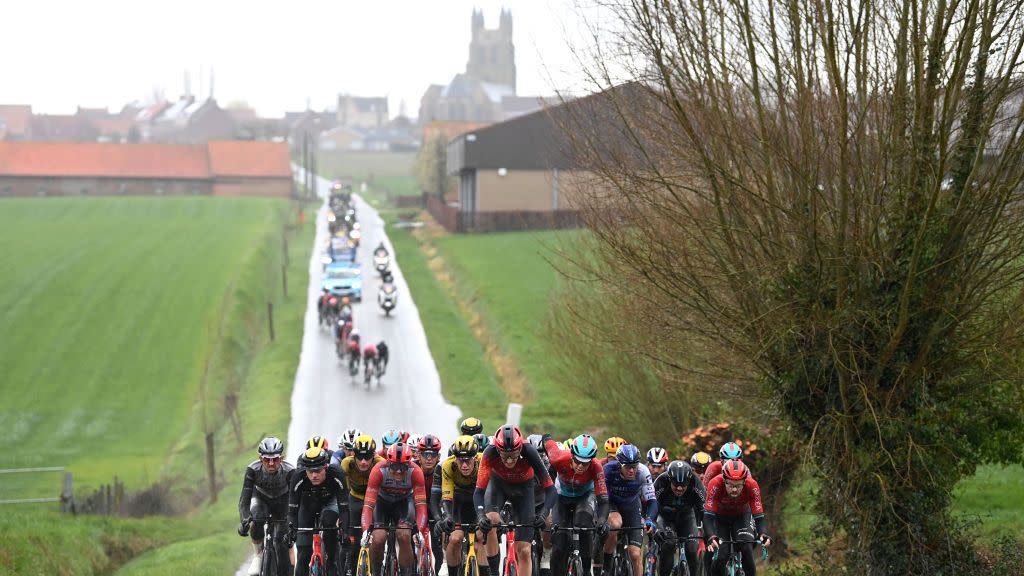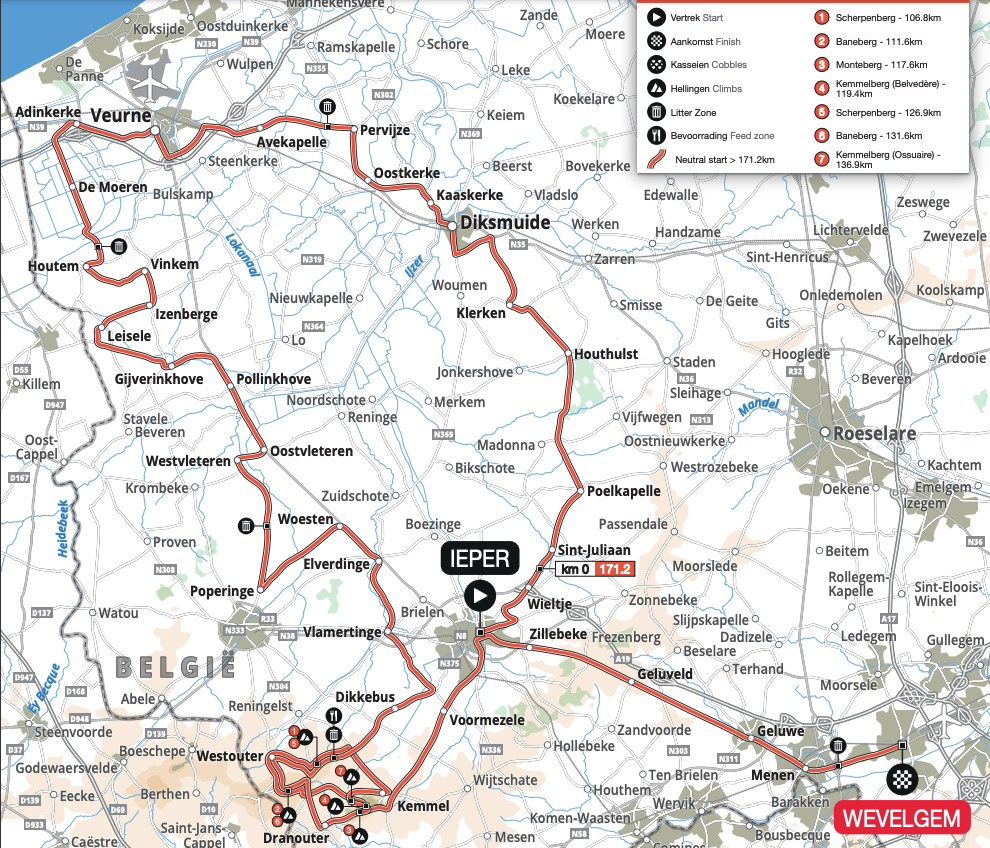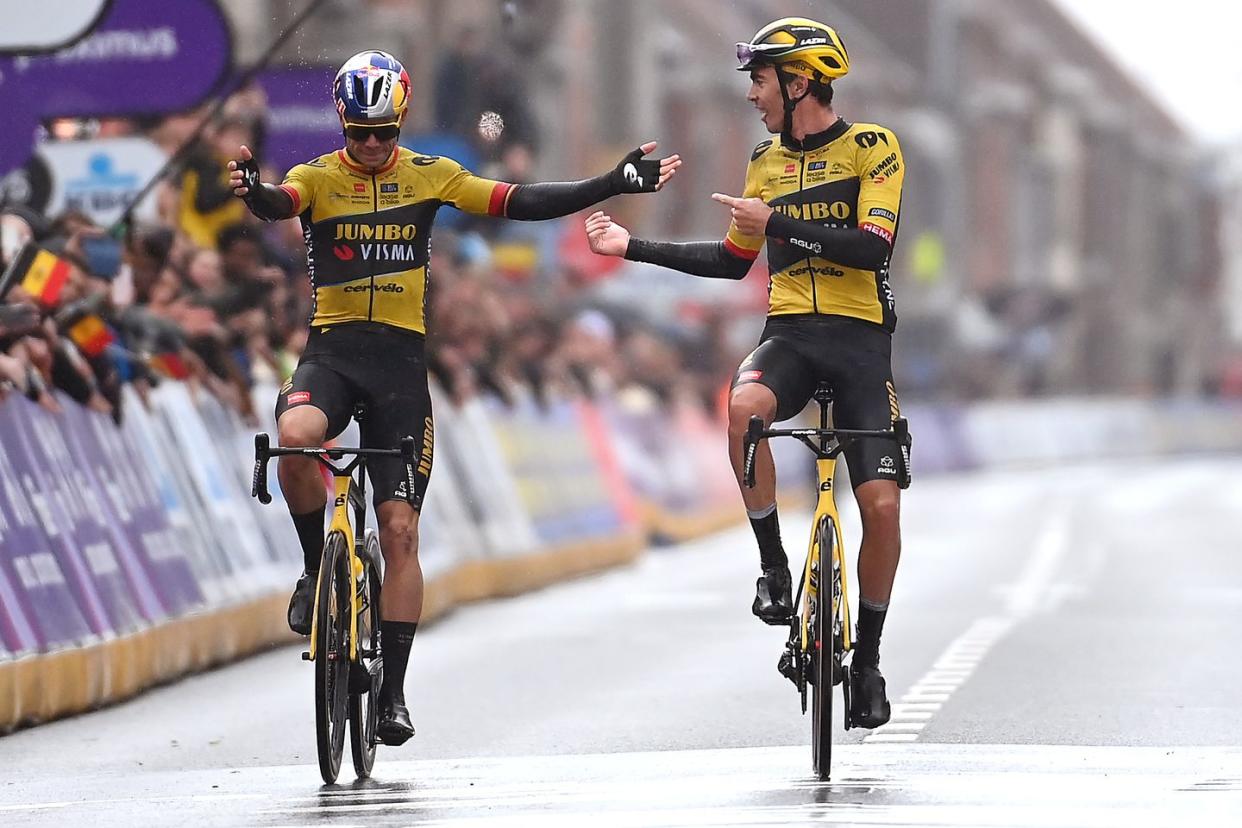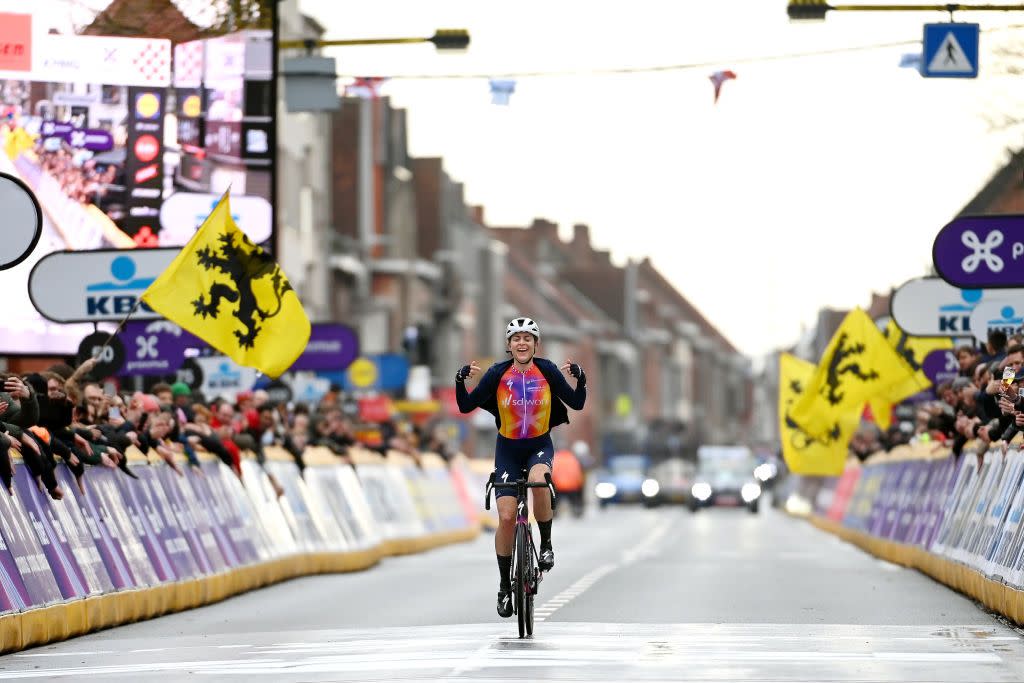Breaking Down the Iconic Ghent-Wevelgem

"Hearst Magazines and Yahoo may earn commission or revenue on some items through these links."
For decades, Ghent-Wevelgem was raced on the Wednesday between the Tour of Flanders and Paris-Roubaix, making it the perfect midweek training event for riders hoping to maintain their form between the two cobbled Monuments. During this time, the event was known as a race most suited to sprinters, as the race’s key climbs were too far from the finish line for breakaways to stay away (although some of them did).
But in 2011, the event was moved to the Sunday before the Tour of Flanders in an attempt to bundle all of the most important Flemish classics into one ten-day festival of beer, frites, and cobbles known locally as Vlaamse Wielerweek (“Flemish Cycling Week”).
The organizers have also added more hills, kilometers, and even a few sections of gravel in an attempt to put the race closer to the level of the longer, hillier, and cobble-ier (we just made that a word) Tour of Flanders. That’s made the race much more challenging than it used to be.
In 2012, a women’s event, starting in Ypres, was added. In 2015, the event’s name became “Ghent-Wevelgem–In Flanders Fields” to honor the 100th anniversary of the start of World War I.
It’s unsurprising that Belgians dominated the men’s event, winning 50 of the race’s 85 editions. And like many women’s races in the last decade, the Dutch have owned the women’s event, winning 5 out of 12 editions since the race was first run in 2012.
Here’s everything you need to know about Sunday’s Ghent-Wevelgem:
The Route
Despite being called Ghent-Wevelgem, both the men’s and women’s races have started in Ypres since 2020 (when the event was moved to October due to COVID-19). At the center of an area that hosted three costly battles during World War I—and has since become a central starting place for tourists looking to visit the many cemeteries, memorials, and other historic sites throughout the area, Ypres is perhaps a more fitting starting place for the race, especially “In Flanders Fields” was added to the event’s name in 2015.
It also makes sense geographically since the race generally avoids the Flemish Ardennes—an area home to the hills featured in races like the E3 Saxo Classic and the Tour of Flanders—in favor of the flatter, windier terrain that stretches across the province of West Flanders and into Northern France.
The men begin their 253K race by passing through the Menin Gate, a memorial to the soldiers who died in the area during World War I, before embarking on a tour of West Flanders that takes them out toward the Belgian coast and then down into the heart of the “Flanders Fields” immortalized by John McCrae’s poem in 1915.

After about 150K of racing, the men will complete three laps centered around a cluster of hills, each shorter than the one before it. The first lap takes the riders over four of the race’s nine climbs: the Scherpenberg, the Baneberg, the Monteberg, and the first ascent of the Kemmelberg, a steep, cobbled climb that was the site of several bloody battles during World War I, and is now the strategic focal point of the race.
After quickly descending the other side of “the Kemmel,” the men continue east toward three sections of “plugstreets.” A term coined by British soldiers during World War I due to their proximity to the town of Ploegsteert, the “plugstreets” are white gravel roads connecting famous sites associated with World War I, including Hill 63, the site of the Christmas Truce of 1914, and the Catacombs. This wooded area was once home to a series of tunnels dug under Hill 63 by Australian and New Zealand soldiers.
The plugstreets are narrow and technical, but flat compared to the white gravel roads of Italy’s Strade Bianche, so they don’t usually play a significant role in determining the race's outcome. They are beautiful, though, and they provide a stark reminder of the actual battles that were fought on these fields more than a century ago.
From the plugstreets, the men head back for a second lap over the four climbs from their first loop—including another passage over the Kemmelberg—but in a different order. The last lap takes them back over the Baneberg before one more time up the Kemmelberg, but this time from its steepest side.
It’s on the second or third ascent of the Kemmelberg that the winning selection is usually made, with a breakaway or a small group of riders pulling away from the peloton and heading back to Ypres and then on to the finish in Wevelgem, about 35K away.
In most races, 35K of flat, open roads would be more than enough time for an organized peloton to bring back whoever’s escaped. But this is Ghent-Wevelgem—a 253K Flemish classic—and the weather, well the wind at least, is usually miserable. Assuming the strongest riders in the race make it over the last ascent of the Kemmelberg at the front of the race, it’s “game over” for anyone left behind.

The 171K women’s race also begins in Ypres, but takes a shorter route through West Flanders before hitting the hills. Upon entering the “hill zone,” the women will tackle the same four climbs as the men do on their first loop–the Scherpenberg, the Baneberg, the Monteberg, and the Kemmelberg–but will then skip the plugstreets and the second ascent of the Kemmel.
Then they’ll loop around for a second and final time, this time covering the Scherpenberg, the Baneberg, and the Kemmelberg–from its hardest side. Then they’ll follow the same windswept route to the finish as the men: first north to Ypres, then southeast toward Wevelgem.
The weather: rainy and windy
One of the most distinctive features of any edition of Ghent-Wevelgem is the wind: in some years, winds coming across or down from the North Sea have literally blown riders off their bikes. When it’s bad, the race is likely to break into echelons at any moment, and riders who don’t pay attention can quickly find themselves in the second or third group on the road and essentially out of the race.
Unfortunately for the riders, Sunday’s forecast calls for rain and wind. The wind is expected to be coming from west-northwest, which means the riders will face crosswind as they head north from the hills toward Ypres and then a tailwind on the run into Wevelgem. That should make for an interesting battle between the breakaway or whatever group is chasing it.
How to Watch
For the next few weeks you’ll appreciate having a subscription to FloBikes ($150/year or $30/month) as it’s the only legal way to stream Ghent-Wevelgem—and several other Belgian races (including the Tour of Flanders)—in the USA and Canada. Both the men’s and women’s events will be available live and on-demand via FloBikes.com, the FloSports IOS app, and the FloSports app for Amazon FireTV, Roku, and Apple TV.
Pro tip: We suggest signing up for the month and then canceling—that gets you access to five important Belgian races—and you can unsubscribe before streaming shifts back to Peacock for the Ardennes Classics like Flèche Wallonne and Liège–Bastogne–Liège and Max for the Giro d’Italia in May.
We’re still a week away from clocks springing ahead in Europe, which means fans on the east coast are five hours behind the race’s local time. The race coverage starts at 8:40 a.m. EDT, but to see the first climb of the Kemmelberg and the plugstreets, you’ll need to be watching by about 9:30 a.m. EDT. If that’s too early, you can wait another 30-45 minutes for the second ascent of the Kemmelberg, then watch the men’s race through to its estimated finishing time at about 11:35 a.m. EDT.
The women’s race coverage starts at 11:00 a.m. EDT. Flanders Classics, the group that organizes many of the, uh, Flemish classics, has started running their women’s races after the men’s in an attempt to get more people to tune in to the action. So, if you quickly switch over to the women’s race after the men’s finishes, you can catch the final ascent of the women’s peloton and the end of their race, which should wrap up around 12:45 p.m. EDT.
What Happened Last Year
Last year’s men’s race ended a bit awkwardly after Belgium’s Wout van Aert (Visma-Lease a Bike) and his teammate, France’s Christophe Laporte, broke away from the field about 50K from the finish line after the Belgian attacked on the second ascent of the Kemmelberg and the Frenchman was the only rider able to follow him.
Perhaps impacted by the cold, rainy weather, the peloton was unable to organize a successful chase, and the Jumbo duo soon gained an advantage of around two minutes over what was left of the peloton.

Inside the final kilometer, a conversation took place between the two riders, and it soon became clear that van Aert, who won Ghent-Wevelgem in 2021 and was clearly looking ahead to the next week’s Tour of Flanders, was going to “gift” the victory to his teammate. It was a controversial decision, especially in the eyes of the home fans who had braved the terrible weather in the hopes of seeing their favorite rider take home the victory. Belgium’s Sep Vanmarcke (Israel-Premier Tech) led home the remnants of the chasing group for third on the day.
In the women’s race, SD-Worx–already winners in the Omloop Het Nieuwsblad and Strade-Bianche–continued its spring dominance, with Switzerland’s Marlen Reusser riding away from the pack on the second ascent of the Baneberg–just before the final ascent of the Kemmelberg–with about 40K to go.
A time trial specialist, Reusser quickly rode away to an insurmountable advantage and won the race by over three minutes–even after taking a wrong turn with about 5K to go. American Megan Jastrab (Team DSM) finished second, and Dutchwoman Maike van der Duin (Canyon-SRAM) finished third.

Riders to Watch
Jasper Philipsen (Alpecin-Deceuninck)
Since Ghent-Wevelgem moved to the Sunday before the Tour of Flanders, no rider has ever won the Flemish classic eight days after winning Milano-Sanremo. But Philipsen—who followed up his first Monument victory last Saturday with his second consecutive win at the Classic Brugge-De Panne on Wednesday—looks like just the rider to pull it off.
You might consider him just a sprinter—after all, he won four stages and the green jersey at last year’s Tour de France. But the Belgian is quickly becoming one of the sport’s best classics riders. He has everything a rider needs to win a race like Ghent-Wevelgem, including a strong team that just so happens to include the rider who dominated Friday’s E3 Saxo Classic.
Mathieu van der Poel (Alpecin-Deceuninck)
After dominating Friday’s E3 Saxo Classic, van der Poel might take a backseat to Philipsen in Ghent-Wevelgem. But if things don’t always go as planned and either Philipsen falters or the race develops such that van der Poel is positioned to go for the win himself, he’ll certainly jump at a chance to add the—which he’s never won before—to his already-impressive resume.
Mads Pedersen (Lidl-Trek)
In last year’s classics last season, and so far this season, Pedersen has shown himself to be just one tier below men like van der Poel, van Aert, and Philipsen. But he’s due for a big cobbled win and Ghent-Wevelgem could be the race. Winner of the race in 2020 and a former world champion, the Dane can handle the hills, and he can sprint.
His Lidl-Trek team has also been one of the deepest in the classics so far, with Belgium’s Jasper Stuyven finishing second in Friday’s E3 Classic, and Latvia’s Toms Skujiņš finishing on the podium at Strade Bianche and eighth in E3. They haven’t yet found a way to overcome Alpecin-Deceuninck and Visma-Lease a Bike, but on Sunday their strength in numbers could pay off.
Elisa Balsamo (Lidl-Trek)
Like Philipsen, Balsamo has had quite an impressive week: first, the former world champion won Sunday’s Trofeo Alfredo Binda, an Italian classic that, in the absence of a women’s Milano-Sanremo, is the most important Italian women’s classic. Then she won Thursday’s Classic Brugge-De Panne for the second time in her career.
The last time she won De Panne, she followed it up with a win in Ghent-Wevelgem three days later. She’s the fastest rider in the sport at the moment and has a strong and experienced squad supporting her that includes Italy’s Elisa Longo Borghini and the Netherlands’ Shirin van Anrooij, both of whom could win the race themselves if Balsamo has a bad day.
Lotte Kopecky (SD Worx-Protime)
The reigning world champion, Kopecky is perhaps the best and most consistent classics rider in the world right now. Last spring, she won the Omloop Het Nieuwsblad and her second Tour of Flanders, and so far this spring, she’s won Strade Bianche, Nokere Koerse, and was the runner-up at the Omloop and the Trofeo Binda.
Now, she heads to Ypres, hoping to add one of the few classics she’s never won before to her palmares. She’ll need to find a way to drop Balsamo in the hills because beating her in a sprint might be a tall order. And while her team is still licking its wounds after some crashes in Nokere, she’ll have two former winners, Reusser and the Netherlands’ Chantal van den Broek-Blaak, by her side.
Chloé Dygert (Canyon//SRAM Racing)
After a lingering Achilles tendon injury delayed the start of her season, Dygert returned to racing on Thursday at the Classic Brugge-De Panne and sprinted to a sixth-place finish. The result was a well-needed confidence boost for the American and makes her a contender for Sunday.
A fantastic time trialist, we wouldn’t be surprised if Dygert tried to emulate Reusser’s long-distance move last year. But her best chance might be to hope for a hard race that sends a small but select group to the finish, where she can try to win the sprint.
Other Riders to Watch: Matej Mohorič, (Bahrain-Victorious), Michael Matthews (Jayco AlUla), Biniam Girmay (Intermarché-Wanty), Puck Pieterse (Fenix-Deceuninck), and Charlotte Kool (dsm-firmenich PostNL).
You Might Also Like
